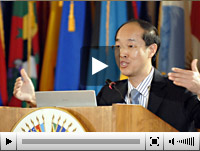- English
Cátedra de las Américas
Twenty Second Lecture - Wan Exiang
Twenty Second Lecture - September 25, 2007
“Judicial Reform in China: Latest Developments and Potential Challenges”
Orador:
Wan Exiang, Vice President of the Supreme People’s Court of the People’s Republic of China
My following presentation will not only cover or focus on the judicial systems latest developments but also on its potential challenges. Today I’d rather not speak as the Vice President of the Supreme Court, but as a professor of law, so that I can be more objective and open-minded. After my presentation, the floor with be open for questions, and my colleagues and I will be more than happy to answer your questions if time allows.
Let me start with the first question of how the Chinese perform and promote judicial reform. There are several different backgrounds. The first one is from an international background: China has already signed and ratified different kinds of treaties as part of the efforts to join the international community. For instance, we have signed human rights, environmental, and intellectual property rights treaties as well as anti-terrorist treaties. Secondly, we gained full membership from the WTO in 2001. Two very important principles like transparency and consistency of application of law are basic requirements of the WTO which push forward the Chinese judiciary to do some reform. On the international front we signed several of bilateral agreements on extradition and judicial cooperation in civil and criminal matters with OAS Member States such as Argentina, Brazil and Peru and with other states like Portugal.
Domestic improvements also advanced the reforms. Supposedly we have a very good record for economic reform. For almost thirty years, China has had a continuous annual growth rate of 9.67% each year. That is one of the longest periods of growth in history. Right now, especially for the leading political group, they have been paying a lot of attention to the basic needs of the people and social welfare matters. We are learning new concepts about sustainable development. Increasing protection of basic human rights will result in a more harmonious society. The fast growing economy leaves the public district needing further protection of their legal rights, thus resulting in more disputes turning into lawsuits. In China we call it a “litigation explosion.” There were only 502,000 cases filed in 1979. In 1989 there were four times as many cases filed. By 1999 there were twelve times as many cases filed as in 1979. There were eight million cases filed between 2000 and 2005. Incredibly, seven million court cases were filed last year alone. How about the first 6 months of this year? There have been five million cases filed already. We expect to handle 10 million cases in China. That is truly a litigation explosion. The market economy requires the rule of law to govern the growing economy and adjudicate the social conflicts. This is the reason why the judicial system is expected to take more responsibilities.
More judiciary reforms came from the legislature. The legislature made material amendments to constitutional law and I would like to mention some of them. The first law was passed in 1993, and it was the turning point from a planned economy to a market economy. The rule of law became a part of our Constitution as one of the amendments in 1999. Then, another very important amendment restored the protection of private property. What was the result of that legislation? More than five million private enterprises were established by the end of 2006. What happened to foreign investment? There were 564,000 invested enterprises by the end of 2006.
Then another very new conception: human rights. For China, human rights are a really new concept. I remember a story, twenty years ago, while I was doing my doctorate dissertation research at Yale Law School, my professor suggested that I write something about human rights. I said, “That is an Indian notion – I don’t know human rights at all.” A similar expression does not exist within Chinese legislative history. The closest thing we have is good governance. But 20 years later, things are very different.

